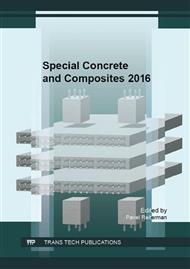[1]
R. Schnidt, P. A. Fast, High volume fly ash concrete usage for skytrain stations, Technical report, (2000).
Google Scholar
[2]
ČSI: ČSN 72 2071: Fly ash for building industry purposes. Common provisions, requirements and test methods, Prague, 2000, p.36 (in Czech), ICS 91. 100. 1.
Google Scholar
[3]
T. P. Singh, Field performance of high volume fly ash concrete – the Indian experience, in 9th CANMET, Poland, (2007).
Google Scholar
[4]
W. Haynes, High volume class F fly ash concrete, in Materials Science of Concrete CEE 8813b, Georgia Tech, (2007).
Google Scholar
[5]
V. Šmilauer, et. al., Utilization of fly ash for massive concrete structures, in Beton TKS, 02/2014, pp.22-27, ISSN 1213-3116. (in Czech).
Google Scholar
[6]
L. Berga, RCC Dams - Roller Compacted Concrete Dams, Volume 1: Proceedings of the IV International Symposium on Roller Compacted Concrete Dams, Madrid, Spain, (2003).
DOI: 10.1201/9780203741276
Google Scholar
[7]
W. Berg, et al., Příručka – Popílek v betonu – základy výroby a použití. ČEZ Energetické produkty, s. r. o., pp.81-86, Praha, 2013. (in Czech).
Google Scholar
[8]
J. Keil, Výstavba vodního díla Orlík – sborník statí, Národní podnik vodní stavby, Praha, 1966. (in Czech).
Google Scholar
[9]
V. B. Ashtankara, H. S. Chore, Development of design mix roller compacted concrete dam at Middle Vaitarana, in Advances in Concrete Construction, Vol. 2, No. 2 (2014) 125-144 DOI: http: /dx. doi. org/10. 12989/acc. 2014. 2. 2. 125.
DOI: 10.12989/acc.2014.2.2.125
Google Scholar
[10]
https: /en. wikipedia. org/wiki/Hungry_Horse_Dam#/media/File: Hngryh2. jpg.
Google Scholar
[11]
http: /www. freeyacht. net/fotoalbum/orlik/vd-prehrada-orlik.
Google Scholar
[12]
M.J. McCarthy, R.K. Dhir: Development of high volume fly ash cements for use in concrete construction, Fuel, 1423-1432, (2005).
DOI: 10.1016/j.fuel.2004.08.029
Google Scholar
[13]
A. M. Neville. Properties of concrete. 2009. New York. pp.503-505. ISBN 0-582-23070-5.
Google Scholar
[14]
M. Hora, P. Reiterman, Assessment of the air-entraining effect of rubber powder and its influence on the frost resistence of concrete, Romanian Journal of Materials 46(3) (2016) 405-413.
Google Scholar
[15]
O. Zobal, O. Holčapek, P. Reiterman, Frost Resistance of Concrete Screed with the Fly Ash Addition, Key Engineering Materials 677 (2016) 80-85. DOI: 10. 4028/www. scientific. net/KEM. 677. 80.
DOI: 10.4028/www.scientific.net/kem.677.80
Google Scholar
[16]
O. Zobal, V. Šmilauer, L. Kopecký, et al., Analysis of concrete from the body of the Orlik dam after fifty years, In: Beton – technologie, konstrukce, sanace, 02/2014, pp.19-25. ISSN 1213-3116. (in Czech).
Google Scholar
[17]
D.P. Bentz, C.F. Ferraris, I. De la Varga, M.A. Peltz, and J.A. Winpigler: Mixture Proportioning Options for Improving High Volume Fly Ash Concretes, Int. J. Pavement Res. Technol. 3(5): 234-240, (2010).
Google Scholar
[18]
R. Siddique: Performance characteristics of high-volume Class F fly ash concrete, Cement and Concrete Research 34, 487-493, (2011).
DOI: 10.1016/j.cemconres.2003.09.002
Google Scholar


